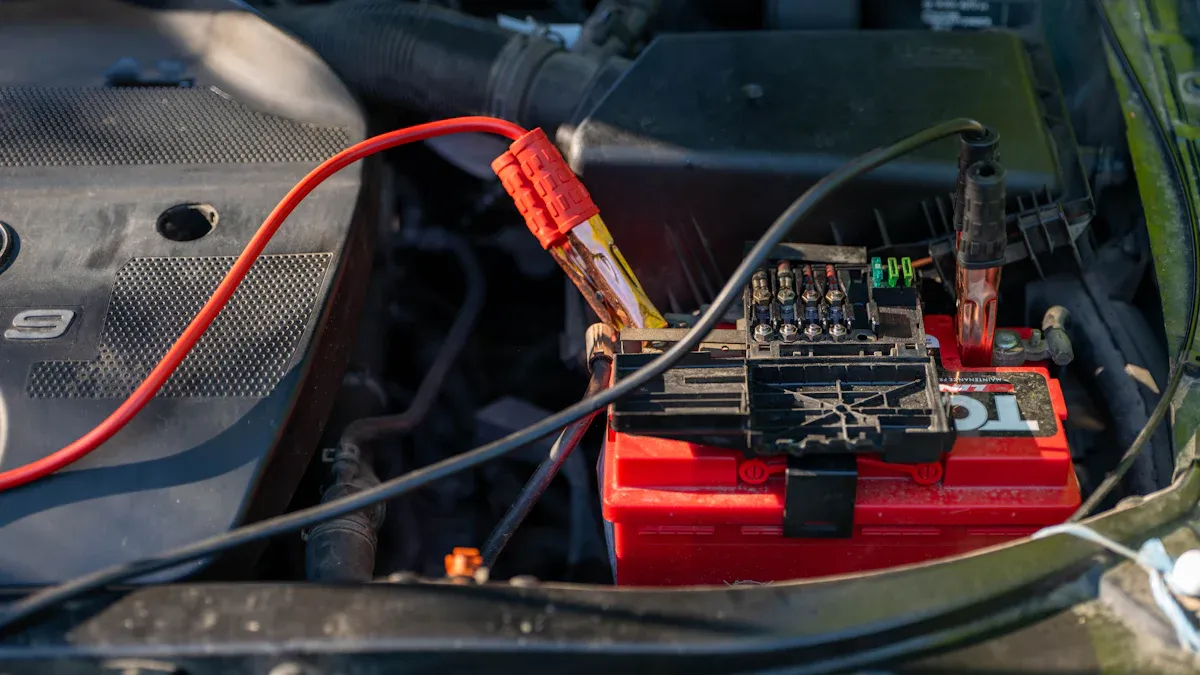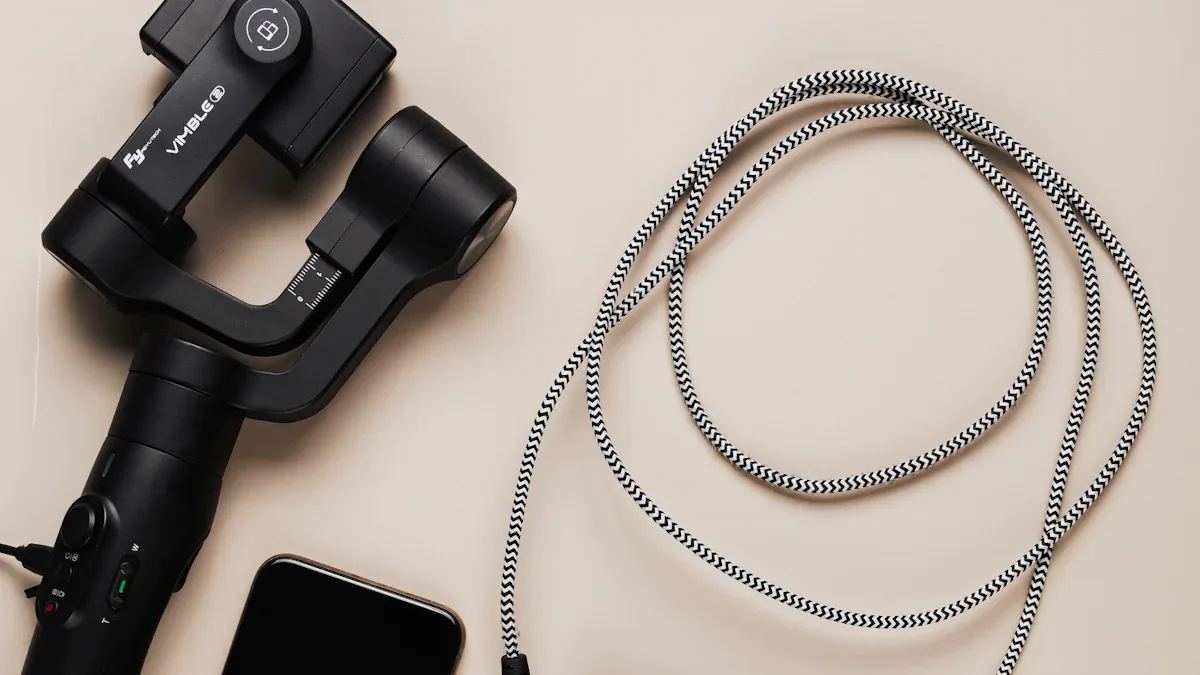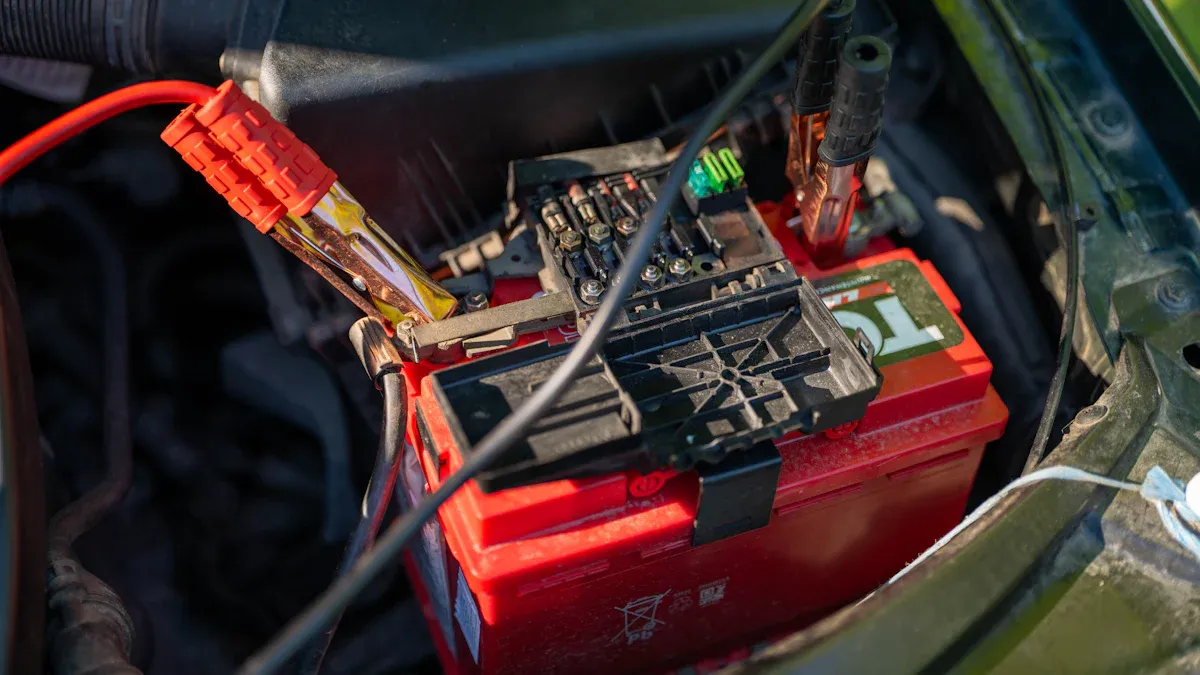
Yes, you can charge a car battery with an RC LiPo charger if you set it up the right way. To safely charge car battery, you need to pay close attention to the charger settings and safety precautions. Many people have run into trouble by overcharging, using the wrong connections, or leaving batteries unattended. Fires can start if you use the wrong charger or let the battery get too hot. When you follow the right steps, you can charge your car battery fast and stay safe.
Tools

RC LiPo Charger
You need a good RC LiPo charger to get the job done right. Not all chargers work for car batteries, so you want one that matches your battery’s voltage and cell count. Look for a charger that supports different cell counts, like 2S to 6S, and lets you adjust the charge rate. A built-in balance charging feature is a must. This keeps each cell in your battery at the same voltage, which helps prevent damage and makes charging safer.
A charger with an LCD screen makes things easier. You can see real-time updates and change settings without guessing. Safety features like overcharge protection, temperature monitoring, and charging timeout help you avoid accidents. Some chargers even have quick charge and storage charge modes. These let you charge faster or prepare your battery for storage, but always use them with care.
Consejo: Always set your charger to the correct mode for your battery. For car batteries, pick the Pb (lead-acid) mode, not LiPo, NiMH, or NiCd.
Connectors
You need the right connectors to hook up your car battery to the charger. Most RC LiPo chargers use banana plugs or alligator clips. Make sure your connectors fit tightly and do not slip off. Loose connections can cause sparks or heat up, which is dangerous.
Some people use a balancer harness. This makes connecting easier and safer, especially if you charge different types of batteries. Always connect the negative terminal first, then the positive. Double-check your setup before you start charging.
Safety Gear
Charging batteries can be risky, so you need to stay safe. Use a LiPo safety bag every time you charge. This bag can slow down a fire and give you time to react. Keep a CO2 fire extinguisher nearby. Never use water if a battery catches fire.
Nota: Charging in a well-ventilated area helps keep things cool and safe. Always inspect your battery and connectors before you start.
With the right tools and safety gear, you can charge your car battery quickly and safely using an RC LiPo charger.
Riesgos
Sobrecarga
Overcharging is one of the biggest dangers when you use an RC LiPo charger for your car battery. If you let the battery charge past its safe limit, you risk damaging it or even causing a fire. Most car batteries and LiPo batteries have a maximum voltage they can handle. Charging above this voltage makes the battery heat up and break down faster.
Consejo: Always set your charger to stop at the right voltage. For most car batteries, that’s around 14.4V. For LiPo cells, never go above 4.2V per cell.
When you overcharge, you shorten the battery’s life. Studies show that charging LiPo batteries past 4.2V per cell causes them to wear out much faster. You might notice your battery doesn’t hold a charge as long or gets hot during use. In the worst cases, overcharging can make the battery swell, leak, or even catch fire.
Here are some common risks you face if you overcharge or use poor charging habits:
- Overheating and swelling of the battery
- Fire or explosion
- Permanent loss of battery capacity
- Shorter battery lifespan
Never leave your battery unattended while charging. Always use a fire-safe bag or container, and keep a fire extinguisher nearby.
Wrong Settings
Using the wrong settings on your RC LiPo charger can cause just as much trouble as overcharging. If you set the voltage or current too high, you risk overheating and damaging the battery. If you set them too low, your battery won’t charge fully, and your car might not start when you need it.
- Setting the charger to the wrong battery type (like NiMH or NiCd) can damage your car battery.
- Incorrect voltage settings can cause the battery to swell, leak, or fail.
- Lack of safety features like overcurrent protection or temperature monitoring increases the risk of overheating.
Nota: Always double-check your charger settings before you start. Make sure you select Pb (lead-acid) mode for car batteries, and match the voltage and current to your battery’s specs.
If you use a charger that doesn’t have cell balancing or safety features, you increase the risk of uneven charging and possible hazards. Stick with chargers that let you adjust settings and monitor the process. This way, you keep your battery healthy and avoid dangerous mistakes.
Setup
Prepare Charger
Getting your RC LiPo charger ready is the first step. You want to make sure everything is set up right before you connect anything. Here’s a simple checklist to follow:
-
Read the Manuals
Take a few minutes to read the manuals for both your charger and your car battery. This helps you understand the specs and safety rules. -
Comprobar compatibilidad
Make sure your RC charger can handle a car battery. Look for a charger that supports Pb (lead-acid) mode. If your charger does not have this mode, do not try to charge a car battery with it. -
Set Up a Safe Charging Area
Find a spot that is well-ventilated and away from anything that can catch fire. Place your battery inside a LiPo safety bag for extra protection. -
Inspect the Battery and Connectors
Look for any damage, swelling, or dirt on the battery. Check the connectors for a tight fit. If you see any problems, do not use the battery. -
Bring Battery to Room Temperature
If your battery feels cold or hot, let it reach room temperature before charging. This helps avoid errors and keeps things safe. -
Plug in the Charger
Connect your charger to a power source, but do not connect the battery yet. -
Select the Right Mode
On your charger, choose the Pb (lead-acid) mode. Never use NiMH or NiCd modes for a car battery. These modes use different charging methods and can cause overheating or even damage your battery. Lead-acid batteries need a charger that switches from current-limit to voltage-limit at the right time. Using the wrong mode can make the charger miss the full charge point, which leads to overcharging and safety risks.
Consejo: Always double-check that you have selected Pb mode before you start. If you are not sure, check your charger’s manual.
- Set Voltage and Current
Set the voltage to about 14.4V. For the current, use the C/10 rule. If your car battery is 40Ah, set the current to 4A (40 divided by 10). This keeps the charging safe and helps your battery last longer.
| Battery Capacity (Ah) | Recommended Charge Current (A) |
|---|---|
| 30 | 3 |
| 40 | 4 |
| 50 | 5 |
Nota: Using the right voltage and current settings helps you charge car battery safely and quickly.
Connect Battery
Now you are ready to connect your battery to the charger. Follow these steps to keep things safe and simple:
-
Check Polarity
Make sure you know which terminal is positive (+) and which is negative (–). Mixing them up can cause sparks or damage. -
Connect the Leads
Attach the charger’s negative lead to the battery’s negative terminal first. Then connect the positive lead to the positive terminal. Use alligator clips or banana plugs for a secure fit. -
Double-Check Connections
Give each connection a gentle tug to make sure it is tight. Loose connections can heat up and cause problems. -
Monitor the Setup
Before you start charging, take a last look at your setup. Make sure the charger is in Pb mode, the voltage and current are set right, and the area is clear of flammable items.
⚡ Recordatorio de seguridad: Never leave your battery unattended while charging. Keep a CO2 fire extinguisher nearby, just in case.
When you follow these steps, you set yourself up for a safe and fast way to charge car battery with your RC LiPo charger. Always stay alert and check your setup before you hit the start button.
Charge Car Battery

Start Charging
You have set up your charger and connected everything. Now it is time to start the process. Turn on your RC LiPo charger and check that the screen lights up. Make sure you have selected the correct mode for your car battery. Double-check the voltage and current settings. You want the voltage at about 14.4V and the current set to C/10 of your battery’s capacity. For example, if your battery is 40Ah, set the current to 4A.
Press the start button on your charger. Most chargers will ask you to confirm your settings. Take a moment to review them before you continue. Once you confirm, the charger will begin to charge car battery. You should see the charging status on the display.
Consejo: Always charge in a well-ventilated area and keep your battery inside a safety bag. Never leave the battery alone while charging.
Monitor Process
While the charger works, keep an eye on the process. Watch the screen for updates on voltage, current, and time. Most RC LiPo chargers show you how much charge has gone into the battery and how long it has been charging.
- Charging at the recommended rate (C/10 for car batteries) helps keep things safe and extends battery life.
- If you use a higher current, the battery may charge faster, but it can get hot and wear out sooner.
- For most batteries, charging at 1C (current equal to battery capacity) takes about one hour. For example:
- A 5000mAh battery charged at 5A will finish in about 1 hour.
- If your charger limits the current to 1A, charging a 2500mAh battery may take 2-3 hours.
Check the battery for any signs of swelling, heat, or strange smells. If you notice anything unusual, stop the charge right away. Your charger may beep or show a message when the battery is full. Do not ignore these alerts.
Nota: Never let the battery get hot to the touch. If it does, stop charging and let it cool down.
Finish Safely
When the charger says the process is complete, do not rush. First, stop the charger to make sure no current is flowing. Disconnect the negative lead, then the positive lead. This order helps prevent sparks or short circuits.
Check the battery voltage. It should be close to the full charge voltage, but not over. Do not leave the battery connected to the charger. This can cause slow drains or even overcharging if the charger malfunctions.
If you do not plan to use the battery right away, store it in a fire-safe container like a LiPo safety bag or a vented ammo can. Some chargers have a storage mode. Use it to bring the battery to a safe storage voltage if you will not use it soon.
- Always monitor the battery during charging and after you finish.
- Never leave the battery in the car or in a hot place after charging.
- If you see any damage or swelling, do not use the battery again.
⚡ Recordatorio de seguridad: Promptly disconnect after you charge car battery. This simple step helps you avoid overcharging and keeps your battery healthy.
Consejos de seguridad
Buenas prácticas
You want to stay safe every time you charge car battery with an RC LiPo charger. Here are some best practices you should always follow:
- Never leave your battery alone while charging. Stay close so you can react if something goes wrong.
- Always check that your charger settings match your battery’s voltage and current. Double-check before you press start.
- Use a LiPo safety bag or a fireproof box when charging or storing batteries. This helps contain any fire if something goes wrong.
- Keep your charging area away from anything flammable. A clear, open space works best.
- Have a dry fire extinguisher or a bucket of sand nearby. You want to be ready just in case.
- Only charge batteries in a well-ventilated area. This keeps things cool and safe.
- Make sure you connect the charger leads with the correct polarity. Wrong connections can cause sparks or damage.
- Use a balance charger if your battery has more than one cell. This keeps all cells at the same voltage.
- Store batteries at about 60% charge if you won’t use them for a while. This helps them last longer.
- Keep batteries away from kids and pets.
Consejo: Always inspect your battery for swelling or damage before charging. If you see anything odd, do not use it.
Mistakes to Avoid
Many people make simple mistakes when they charge car battery with an RC LiPo charger. You can avoid trouble by watching out for these:
- Charging without using a balance lead. This can cause uneven charging and damage your battery.
- Picking the wrong charger mode, like NiMH or NiCd, instead of Pb (lead-acid) for car batteries. This can overheat or ruin your battery.
- Charging a battery that is swollen, dented, or damaged. Always check first.
- Setting the wrong cell count or voltage on your charger. Double-check every time.
- Leaving batteries unattended while charging. Fires can start quickly if you are not watching.
- Trying to charge several batteries at once (parallel charging) without the right setup. This can damage all your batteries.
- Forgetting to use a safety bag or fireproof box. This step protects you and your home.
- Not storing batteries at the right voltage or in a safe place. Batteries last longer and stay safer when stored properly.
🚫 Never charge batteries inside your car or in hidden spots. Always choose a safe, open area.
If you follow these tips and avoid common mistakes, you will charge car battery faster and safer every time.
Solución de problemas
Common Issues
You might run into a few problems when charging your car battery with an RC LiPo charger. Here are some of the most common issues you could face:
- Charger won’t start: Sometimes, the charger does not recognize the battery. This can happen if the connectors are loose or the battery is too low.
- Battery gets hot: If your battery feels warm or even hot, stop charging right away. Heat can mean you set the current too high or the battery is damaged.
- Charger shows error codes: Many chargers display error messages if something goes wrong. These codes often point to wrong settings, bad connections, or a faulty battery.
- Cells out of balance: If you see one cell charging faster than others, your battery may not be balanced. This can shorten battery life and cause safety risks.
- Swelling or strange smells: If your battery swells up or smells odd, disconnect it immediately. This can signal overcharging or a damaged battery.
⚠️ Consejo: Always keep your battery and charger away from anything that can catch fire. Use a fireproof charging bag for extra safety.
Quick Fixes
You can solve most charging problems with a few simple steps. Try these quick fixes if you run into trouble:
- Check all connections. Make sure the leads are tight and the polarity is correct.
- Use the balance charging mode every time. This keeps all cells at the same voltage and helps your battery last longer.
- Watch the charger display. Monitor each cell’s voltage during charging. If you see a big difference, stop and balance the cells.
- Use a bat-safe charge box or a fireproof bag. This keeps you safe if something goes wrong.
- Organize your batteries with bands or labels. This helps you know which ones need charging and which are ready to use.
- Disconnect the battery as soon as it’s fully charged. This prevents swelling and lowers the risk of fire.
🔍 Nota: Most modern chargers have balance charging built in. Use this feature to keep your battery healthy and safe.
If you follow these steps, you can fix most problems fast and keep your charging process smooth and safe.
Charging your car battery with an RC LiPo charger can be quick and safe if you follow the right steps. Always check your battery and connectors before you start. Use a smart balance charger, set the correct mode and current, and keep an eye on the process.
Stay close while charging, use a fireproof bag, and keep a CO2 extinguisher nearby. These habits protect you and your battery every time.
PREGUNTAS FRECUENTES
Can I use any RC LiPo charger for my car battery?
Not every RC LiPo charger works for car batteries. You need a charger with Pb (lead-acid) mode and adjustable voltage. Always check your charger’s manual before you try it.
How long does it take to charge a car battery with an RC LiPo charger?
Charging time depends on your battery size and the charger’s current setting. Most car batteries take 4–8 hours at the recommended C/10 rate. Fast charging can shorten battery life.
What happens if I use the wrong charger mode?
If you pick the wrong mode, you can damage your battery or cause a fire. Always use Pb (lead-acid) mode for car batteries. Never use LiPo, NiMH, or NiCd modes.
Is it safe to leave the battery charging overnight?
No, you should never leave a battery charging overnight or unattended. Problems can happen fast. Stay nearby and check the battery often.

